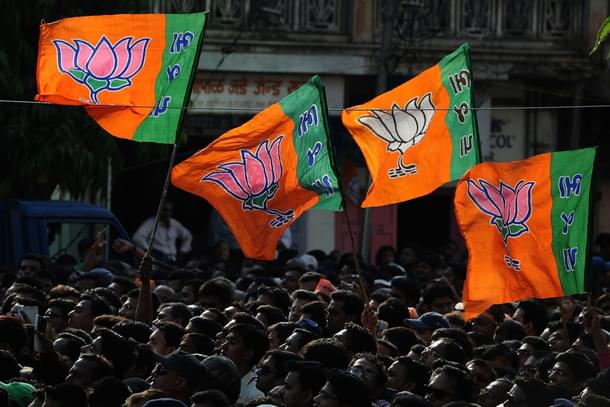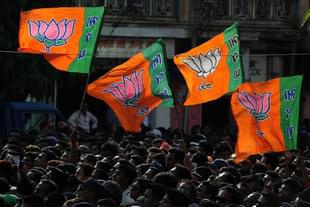Politics
Five Tasks Waiting For The New BJP President
Abhishek Kumar
Jun 10, 2024, 05:35 PM | Updated Jun 11, 2024, 11:51 AM IST
Save & read from anywhere!
Bookmark stories for easy access on any device or the Swarajya app.


With the swearing in of Modi 3.0's cabinet yesterday (9 June), it was confirmed that J P Nadda, the current president of the BJP, will be part of the new government.
Given the fact that the Bharatiya Janata Party (BJP) follows the ‘one person, one post’ principle, it is certain that the party will get a new president in the next few weeks.
With three crucial state elections in the next six months, the new president will have his/her task cut out.
Here are five things that he/she will need to fix, and fix quickly:
Reach Out To Party Workers
One common factor in most major analyses behind the decline in seats is discontentment among party workers. People dedicated to influencing individual voting patterns are not being given the respect they deserve. At many places, it was seen that the candidates simply did not get along with party workers — R K Singh, the power minister, lost because of it from Arrah.
A fresh approach, taking workers on board in ticket distribution, advertisements, and campaign strategy needs to be adopted. A top-down approach directly from the party president will uplift morale more quickly.
Decentralised Decision Making
Go to a district or block unit of the party and ask about a key decision, the standard response is — "everything comes from the top". This is the crux of the problem. Like karyakartas, local officials also feel helpless. There is very little decision-making power in their hands.
The way tickets were distributed to turncoats from other parties and unpopular candidates and its disastrous consequences showcase the fatality of this approach. Except for K Annamalai in Tamil Nadu, it is hard to find when a key state figure was entrusted with decision making.
Handling more decision-making powers down the hierarchy will infuse a sense of vigour, ultimately trickling down to karyakartas.
Fix The State Units
There are serious troubles in a few state units of the party.
For instance, in West Bengal, senior leader Suvendu Adhikari and central leaders deputed for election are not seen in high regard, especially after the debacle in the election. Former party chief Dilip Ghosh is ready to revolt. Allegedly, favoritism and ego battles rule the roost in West Bengal.
This type of revolt dilutes the coordination, leading to haphazard campaigns, the results of which are apparent. The feedback loop, which is the most important node in ticket distribution, is also highly perturbed as leaders themselves tend to focus on doing the bare minimum as the party's loss will be used as a tool to push themselves up in the hierarchy.
The situation is not so different in other state units too, especially in east and north India. It demands a fix on war footing.
Identify What All Went Wrong In Uttar Pradesh
The BJP lost 29 seats in UP, the centre of the Hindi heartland. Even Ayodhya, where the Ram Mandir was built with the Prime Minister leading the pran prathishtha, the party lost. A multitude of reasons are coming to the forefront.
For one, the candidates fielded by the party showed too much heavy-handedness. This created an image of them being too powerful to approach.
Secondly, there was a lack of coordination between local karyakartas and top leadership. Karyakartas’ demands were not being listened to as leaders became too complacent.
Thirdly, for every problem existing MPs created, their solution was taking the name of Prime Minister Narendra Modi. The assumption was that no matter how bad the candidate was, the Modi wave would be a winning factor, rather than a local or regional issues. They did not even look for a proper coalition to get Dalit votes.
If anything, the UP debacle shows that complacency can be fatal.
With the state set for multiple by polls, the new BJP chief has his/her task cut out.
Reimagining Punjab
Punjab is changing, both politically and socially.
Not long ago, discussions around ‘chai ki tapri’ in urban and semi-urban clusters used to shape people’s opinions in villages. The inclusive approach of pop culture, glamourisation of violence, drugs, and declining prosperity have had a deleterious impact on villagers’ psyche.
More and more voters in villages are now seeing themselves as independent of the city's psyche. Add to that, cash poured in by evangelicals hell-bent on turning Punjab into a Christian state.
Amidst all of this, Khalistani elements are quickly taking up the vacant space. The violence in farmers’ protests and the purported narrative around the Indian government (read Narendra Modi) handling it has polarised Punjab. No wonder, an out-and-out Khalistani won from the Khadoor Sahib Lok Sabha seat, that too from jail.
Despite having first-hand experience of all this, the BJP did not target village voters in the way it should have done. Reports from the ground suggest that the alarming situation there does not reach the upper echelons of the party.
In a volatile border state like Punjab, this ‘chalta hai’ approach will paralyse BJP’s prospects, having the effect of endangering national security as well as converting people in large numbers.
Protecting sentiments in and around border requires a fresh approach, free of old and cluttered thinking.
Abhishek is Staff Writer at Swarajya.





